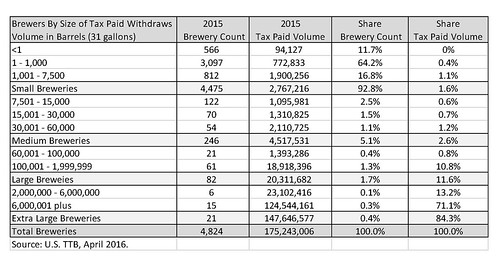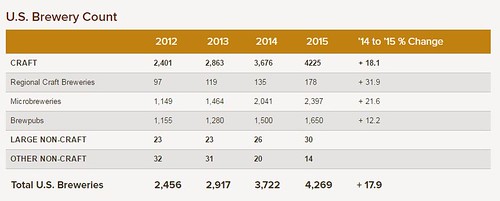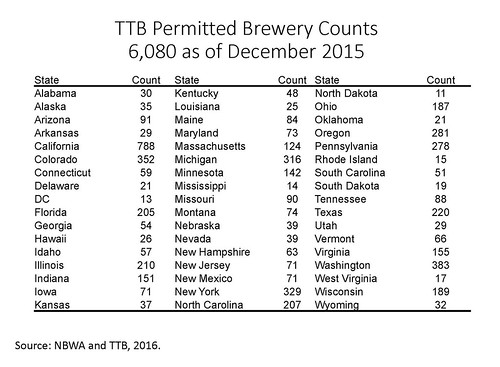The total number of breweries operating in the U.S. at the end of 2015?
Four thousand eight hundred and twenty-four (4,824) breweries, says the TTB (the Alcohol and Tobacco Tax and Trade Bureau of the U.S. Department of the Treasury). Together, these breweries brewed 175,243,006 barrels of beer.
The National Beer Wholesalers Association (NBWA) has just published this data, with analysis from its chief economist, Lester Jones, in conjuction with its national legislative conference being held this week in Washington, D.C.

Jones further broke down the data into the production percentage and barrelage of breweries per categories of size. Thus:
- Small breweries: fewer than 7,500 barrels
▶ 4,475 breweries (92.8% of all breweries active in the U.S.)
▶ produced 2,767,216 barrels (1.1% of all beer brewed in the U.S. in 2015). - Medium breweries: 7,500 - 60,000 barrels
▶ 246 breweries (5.1% of all U.S. breweries)
▶ produced 4,517,531 barrels (2.6% of all beer brewed in U.S.) - Large breweries: 60,001 - 2 million barrels
▶ 82 breweries (1.3% of all U.S. breweries)
▶ produced 18,918,396 barrels (11.6% of all beer brewed in the U.S.) - Extra-large breweries: over 2 million barrels
▶ 21 breweries (0.4% of all U.S. breweries)
▶ produced 147,646,577 barrels (84.3% of all beer brewed in the U.S.)
- 60,001 to 100,000 barrels
▶ 21 breweries (0.4% of all U.S. breweries)
▶ produced 1,393,286 barrels of beer (0.8% of all beer) - 100,001 to 1,999,999
▶ 61 breweries (1.3% of all U.S. breweries)
▶ produced 18,918,396 barrels of beer (10.8% of all beer)
Jones notes the anomaly of 566 breweries producing a barrel or less (!) but accounting for over 94,000 barrels per year. These 'brewing' companies contract with other breweries to produce their beers, a practice which other larger breweries may do as well.
A big takeaway from the numbers (literally and figuratively) is that only it's only a handful of breweries that are producing more than 84% of all the beer in the U.S., an amount more than five times that brewed by all the rest of the 4,803 combined. It's not simply the mainstream macro-breweries, such as Anheuser-Busch InBev and SABMiller, in that group. It's also the 'big craft' breweries, such as Boston Beer (Sam Adams, etc.), Yuengling, Sierra Nevada, New Belgium, and others. In fact, just those 'big craft' breweries themselves, all producing between two and six million barrels per year, accounted for 13.2% of all the beer produced in the U.S. in 2015: 23,102,416 barrels. That's a trend that will be putting pressure on the BA in holding together its small and large 'craft' brewery members under one rubric. And, indeed ...
The Brewers Association had a different count.
The [U.S.] Brewers Association reported a lower count for 2015, than the NBWA: a total of 4,269 breweries. Nevertheless, either number is a historical high. In 1873, the BA reports, there were 4,131 breweries, the most in the U.S. until now.The TTB and the NBWA base their numbers on those breweries with brewers licenses who have paid excise tax during the year. The BA has different criteria and different categories.
A microbrewery, for example, it considers to brew fewer than 15,000 barrels per year; a brewpub to be a restaurant-brewery that sells 25 percent or more of its beer on-site; a regional brewery to brew between 15,000 and 6,000,000 barrels per year; and, a large brewery, to brew in excess of that. As to what the BA considers 'craft' of non-'craft': that's a tripartite definition combining arbitrary production limits and subjective concerns.
- Small
Annual production of 6 million barrels of beer or less (approximately 3 percent of U.S. annual sales). Beer production is attributed to the rules of alternating proprietorships. - Independent
Less than 25 percent of the craft brewery is owned or controlled (or equivalent economic interest) by an alcoholic beverage industry member that is not itself a craft brewer. - Traditional
A brewer that has a majority of its total beverage alcohol volume in beers whose flavor derives from traditional or innovative brewing ingredients and their fermentation. Flavored malt beverages (FMBs) are not considered beers.
Breweries to come
The TTB also reports on the number of breweries that have Brewer's Licenses, whether those breweries are brewing now or will soon.The top ten states in the U.S., by "permitted" breweries:
- 1. California: 788 breweries
- 2. Washington state: 383
- 3. Colorado: 352
- 4. New York: 329
- 5. Michigan: 316
- 6. Oregon: 281
- 7. Pennsylvania: 278
- 8. Texas: 220
- 9. Illinois: 210
- 10. North Carolina: 207
- The state with the least is North Dakota at 12. The city of Washington, D.C. —neither a state nor a city within a state— is just above it, with 13.
Jones of the NBWA notes that breweries were opening at the rate of almost four per day in 2015. But here's the kicker. In addition to those four thousand eight hundred and twenty-four (4,824) breweries that were operating in 2015, there were one thousand eight hundred and eleven (1,811) more not yet brewing but with their licenses in hand. That's six thousand and eighty (6, 080) "permitted" breweries already on the playing field in the U.S. for 2016.
Hang on sports, fans!!
-----more-----
- Read the entire report form the NBWA: here.
- Read the NBWA's mid-year 2015 report on 'craft' beer: here.
- The BA has published its lists of the top 50 overall brewing companies, by sales volumes, in 2015, and the top 50 'craft' breweries of 2015, by sales volume (according to its 'craft' definition). See those: here.
- Looking back four years, according to the BA there were 3,722 breweries in the U.S. in 2014; 2,917 in 2013; 2,456 in 2012.
- Since this blog was long reported from the mid-Atlantic area, I'll mention the ranking the 'permitted' brewery rank of the three area jurisdictions. Again, the city of Washington, D.C. was at #50 with 13 breweries; the commonwealth (state) of Virginia at #14 with 155; the state of Maryland, #23 with 73 breweries.
- A barrel of beer, when a brewery's production is reported, is not a physical container. Rather, it's a unit of volume measurement equal to thirty-one U.S. gallons. Read more: here.
- For more from YFGF:
- Follow on Twitter: @Cizauskas.
- Like on Facebook: YoursForGoodFermentables.
- Follow on Flickr: Cizauskas.
- Follow on Instagram: @tcizauskas.











No comments:
Post a Comment
Comment here ...